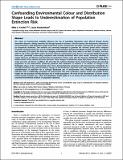Por favor, use este identificador para citar o enlazar a este item:
http://hdl.handle.net/10261/126293COMPARTIR / EXPORTAR:
 SHARE SHARE
 CORE
BASE CORE
BASE
|
|
| Visualizar otros formatos: MARC | Dublin Core | RDF | ORE | MODS | METS | DIDL | DATACITE | |

| Título: | Confounding Environmental Colour and Distribution Shape Leads to Underestimation of Population Extinction Risk |
Autor: | Fowler, Mike S. CSIC; Ruokolainen, Lasse | Fecha de publicación: | 11-feb-2013 | Editor: | Public Library of Science | Citación: | PLoS ONE 8(2): e55855 (2013) | Resumen: | The colour of environmental variability influences the size of population fluctuations when filtered through density dependent dynamics, driving extinction risk through dynamical resonance. Slow fluctuations (low frequencies) dominate in red environments, rapid fluctuations (high frequencies) in blue environments and white environments are purely random (no frequencies dominate). Two methods are commonly employed to generate the coloured spatial and/or temporal stochastic (environmental) series used in combination with population (dynamical feedback) models: autoregressive [AR(1)] and sinusoidal (1/f) models. We show that changing environmental colour from white to red with 1/f models, and from white to red or blue with AR(1) models, generates coloured environmental series that are not normally distributed at finite time-scales, potentially confounding comparison with normally distributed white noise models. Increasing variability of sample Skewness and Kurtosis and decreasing mean Kurtosis of these series alter the frequency distribution shape of the realised values of the coloured stochastic processes. These changes in distribution shape alter patterns in the probability of single and series of extreme conditions. We show that the reduced extinction risk for undercompensating (slow growing) populations in red environments previously predicted with traditional 1/f methods is an artefact of changes in the distribution shapes of the environmental series. This is demonstrated by comparison with coloured series controlled to be normally distributed using spectral mimicry. Changes in the distribution shape that arise using traditional methods lead to underestimation of extinction risk in normally distributed, red 1/f environments. AR(1) methods also underestimate extinction risks in traditionally generated red environments. This work synthesises previous results and provides further insight into the processes driving extinction risk in model populations. We must let the characteristics of known natural environmental covariates (e.g., colour and distribution shape) guide us in our choice of how to best model the impact of coloured environmental variation on population dynamics. © 2013 Fowler, Ruokolainen. | Versión del editor: | http://dx.doi.org/10.1371/journal.pone.0055855 | URI: | http://hdl.handle.net/10261/126293 | DOI: | 10.1371/journal.pone.0055855 | Identificadores: | doi: 10.1371/journal.pone.0055855 issn: 1932-6203 |
| Aparece en las colecciones: | (IMEDEA) Artículos |
Ficheros en este ítem:
| Fichero | Descripción | Tamaño | Formato | |
|---|---|---|---|---|
| Fowler-PLoS-ONE-2013-v8-e55855.pdf | 702,97 kB | Adobe PDF |  Visualizar/Abrir |
CORE Recommender
PubMed Central
Citations
3
checked on 11-abr-2024
SCOPUSTM
Citations
12
checked on 11-abr-2024
WEB OF SCIENCETM
Citations
11
checked on 25-feb-2024
Page view(s)
262
checked on 18-abr-2024
Download(s)
225
checked on 18-abr-2024

